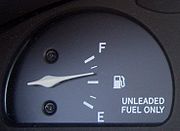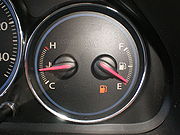
Fuel gauge
Encyclopedia


Measuring instrument
In the physical sciences, quality assurance, and engineering, measurement is the activity of obtaining and comparing physical quantities of real-world objects and events. Established standard objects and events are used as units, and the process of measurement gives a number relating the item...
used to indicate the level of fuel
Fuel
Fuel is any material that stores energy that can later be extracted to perform mechanical work in a controlled manner. Most fuels used by humans undergo combustion, a redox reaction in which a combustible substance releases energy after it ignites and reacts with the oxygen in the air...
contained in a tank
Fuel tank
A fuel tank is safe container for flammable fluids. Though any storage tank for fuel may be so called, the term is typically applied to part of an engine system in which the fuel is stored and propelled or released into an engine...
. Commonly used in cars, these may also be used for any tank including underground storage tank
Underground storage tank
An Underground Storage Tank , in United States environmental law, is a tank and any underground piping connected to the tank that has at least 10 percent of its combined volume underground.-Tank types:...
s.
As used in cars, the gauge consists of two parts:
- The sensing unit
- The indicator
The sensing unit usually uses a float connected to a potentiometer
Potentiometer
A potentiometer , informally, a pot, is a three-terminal resistor with a sliding contact that forms an adjustable voltage divider. If only two terminals are used , it acts as a variable resistor or rheostat. Potentiometers are commonly used to control electrical devices such as volume controls on...
. As the tank empties, the float drops and slides a moving contact along the resistor, increasing its resistance. In addition, when the resistance is at a certain point, it will also turn on a "low fuel" light on some vehicles.
Meanwhile, the indicator unit (usually mounted on the dashboard
Dashboard
A dashboard is a control panel placed in front of the driver of an automobile, housing instrumentation and controls for operation of the vehicle....
) is measuring and displaying the amount of electrical current flowing through the sending unit. When the tank level is high and maximum current is flowing, the needle points to "F" indicating a full tank. When the tank is empty and the least current is flowing, the needle points to "E" indicating an empty tank.
The system is fail-safe
Fail-safe
A fail-safe or fail-secure device is one that, in the event of failure, responds in a way that will cause no harm, or at least a minimum of harm, to other devices or danger to personnel....
; a fault that opens the electrical circuit causes the indicator to show the tank as being empty (which will provoke the driver to refill the tank (in theory)) rather than full (which would allow the driver to run out of fuel with no prior notification). However this system has a potential risk associated with it. An electric current is sent through the variable resistor to which a float is connected, so that the value of resistance depends on the fuel level. In most of automotive fuel gauges such resistors are on the inward side of gauge i.e. inside fuel tank. Sending current through such a resistor has fire hazard (and an explosion risk) associated with it. Therefore there is demand for another safer (and cheaper) method to be invented.
Systems that measure large fuel tanks (including underground storage tanks) may use the same electro-mechanical principle or may make use of a pressure sensor, sometimes connected to a mercury
Mercury (element)
Mercury is a chemical element with the symbol Hg and atomic number 80. It is also known as quicksilver or hydrargyrum...
manometer
Pressure measurement
Many techniques have been developed for the measurement of pressure and vacuum. Instruments used to measure pressure are called pressure gauges or vacuum gauges....
.
Many aircraft
Fixed-wing aircraft
A fixed-wing aircraft is an aircraft capable of flight using wings that generate lift due to the vehicle's forward airspeed. Fixed-wing aircraft are distinct from rotary-wing aircraft in which wings rotate about a fixed mast and ornithopters in which lift is generated by flapping wings.A powered...
use a different fuel gauge design principle. An aircraft may use a number (around 30 on an A320) of low voltage tubular capacitor probes where the fuel becomes the dielectric
Dielectric
A dielectric is an electrical insulator that can be polarized by an applied electric field. When a dielectric is placed in an electric field, electric charges do not flow through the material, as in a conductor, but only slightly shift from their average equilibrium positions causing dielectric...
. At different fuel levels, different values of capacitance are measured and therefore the level of fuel can be determined. In early designs, the profiles and values of individual probes were chosen to compensate for fuel tank shape and aircraft pitch and roll attitudes. In more modern aircraft, the probes tend to be linear (capacitance proportional to fuel height) and the fuel computer works out how much fuel there is (slightly different on different manufacturers). This has the advantage that a faulty probe may be identified and eliminated from the fuel calculations. In total this system can be more than 99% accurate. Since most commercial aircraft only take on board fuel necessary for the intended flight (with appropriate safety margins), the system allows the fuel load to be preselected, causing the fuel delivery to be shut off when the intended load has been taken on board.

